How far does screening women for domestic (partner) - NIHR Health ...
How far does screening women for domestic (partner) - NIHR Health ...
How far does screening women for domestic (partner) - NIHR Health ...
You also want an ePaper? Increase the reach of your titles
YUMPU automatically turns print PDFs into web optimized ePapers that Google loves.
48<br />
Review Question IV<br />
access resources when these were available; and<br />
provided an environment where they could talk<br />
with a counsellor and friends. Follow-up did not<br />
extend beyond the intervention period. At the<br />
end of the programme the experimental group<br />
had significant improvements on the ‘belonging’<br />
function of social support, and had significant<br />
reductions in psychological distress and health-care<br />
utilisation. The authors reported non-significant<br />
improvements in ‘tangible’ social support and total<br />
social support, but no data were presented.<br />
An individually randomised controlled trial<br />
conducted by McFarlane and colleagues in two<br />
urban primary care public health clinics and two<br />
<strong>women</strong>, infants and children clinics compared a<br />
nurse case management intervention with a referral<br />
card that listed a safety plan and sources of <strong>partner</strong><br />
violence services. 123 Project nurses received a 40hour<br />
training programme based on the March of<br />
Dimes protocol prior to study implementation.<br />
Advocacy sought to empower the <strong>women</strong> by<br />
increasing independence and control through<br />
encouraging the use of a 15-item safety-promoting<br />
behaviour checklist, supplemented with supportive<br />
care and anticipatory guidance by a nurse and<br />
guided referrals tailored to the <strong>women</strong>’s individual<br />
needs, such as job training. There were five<br />
20-minute case management sessions. The control<br />
group received standard refuge services provided<br />
to all residents. No effect <strong>for</strong> the intervention was<br />
found at the 24-month follow-up: all outcomes<br />
(use of safety behaviours and community<br />
resources, threats, assault, homicide risk and work<br />
harassment) improved over time, regardless of<br />
group allocation. Study participants did not report<br />
any adverse effects. For findings relating to the<br />
children of the participants, see Interventions with<br />
children of abused <strong>women</strong> below.<br />
Sullivan and colleagues tested the effect of an<br />
advocacy intervention aimed at abused <strong>women</strong> and<br />
their children (aged between 7 and 11 years) using<br />
an individually randomised controlled trial study<br />
design. 124 The intervention took place in <strong>women</strong>’s<br />
homes in an urban setting. Advocacy was based on<br />
the individual needs of the mother and child, but<br />
all sessions actively assisted mothers in accessing<br />
community resources. The majority (79%) of the<br />
<strong>women</strong> were recruited when leaving a <strong>domestic</strong><br />
violence refuge and the remainder were recruited<br />
from community family service organisations or<br />
social services. Unspecified control group care was<br />
compared with a multicomponent intervention<br />
consisting of: (1) a highly trained paraprofessional<br />
who worked <strong>for</strong> 16 weeks and helped mothers to<br />
mobilise and access community resources; (2) the<br />
same paraprofessional who advocated similarly <strong>for</strong><br />
the children <strong>for</strong> 16 weeks; (3) a 10-week support<br />
and education group attended by the children<br />
within the 16 weeks. Families saw their advocates<br />
<strong>for</strong> a mean of 10 hours a week, averaging 5 hours<br />
with the children and an additional 2.7 hours<br />
with the <strong>women</strong>. The basis of advocacy and the<br />
content of the sessions was similar to that of<br />
earlier intervention studies by Sullivan and her<br />
colleagues 125–129 (reported under Studies included<br />
in our previous review below). An important part<br />
of the intervention was ensuring that the advocate<br />
was no longer needed after 16 weeks. At a 4-month<br />
follow-up, <strong>women</strong> in the intervention group had<br />
significantly reduced depression and improved<br />
self-esteem. Mothers who received advocacy also<br />
reported better quality of life than mothers in the<br />
control group, although this was not statistically<br />
significant. <strong>How</strong>ever, the intervention did not have<br />
an effect on the incidence of actual abuse or social<br />
support. For findings relating to the children,<br />
see Interventions with children of abused <strong>women</strong><br />
below.<br />
Studies included in our<br />
previous review<br />
Here we summarise the findings of studies<br />
examined in our previous review. 11 In two separate<br />
randomised controlled studies (a pilot and a<br />
main study) by Sullivan and colleagues, 125–129<br />
undergraduate psychology students were trained<br />
to provide 10 weeks of community-based advocacy<br />
to severely abused <strong>women</strong> exiting from refuges.<br />
Advocacy was tailored to the individual <strong>women</strong>’s<br />
needs to help them to access community resources<br />
(such as housing, employment, legal assistance,<br />
transport and childcare), as well as empowering<br />
the <strong>women</strong> themselves. A number of beneficial<br />
outcomes were observed over time. In the main<br />
study, at the end of the advocacy period, there<br />
was a significant improvement in the <strong>women</strong>’s<br />
perceived effectiveness in obtaining resources,<br />
quality of life and perceived social support as<br />
compared with baseline and control group scores.<br />
At 10 weeks postintervention, the <strong>women</strong> who<br />
received advocacy reported improvement in<br />
their quality of life, and this was maintained at<br />
6 months after the cessation of the programme.<br />
Initial improvements in perceived effectiveness in<br />
obtaining resources and perceived social support<br />
were no longer statistically significant at 6 months.<br />
<strong>How</strong>ever, when followed up 2 years after the<br />
cessation of advocacy, <strong>women</strong> in the advocacy<br />
group reported significantly less physical abuse
















